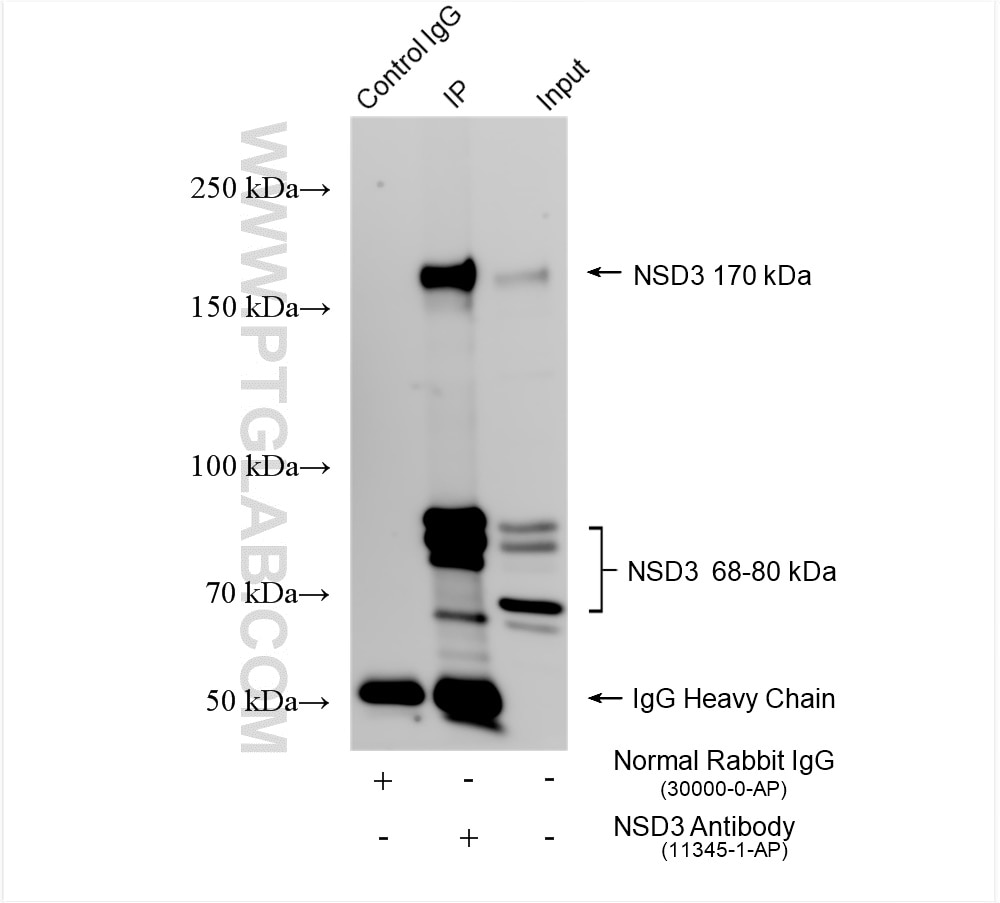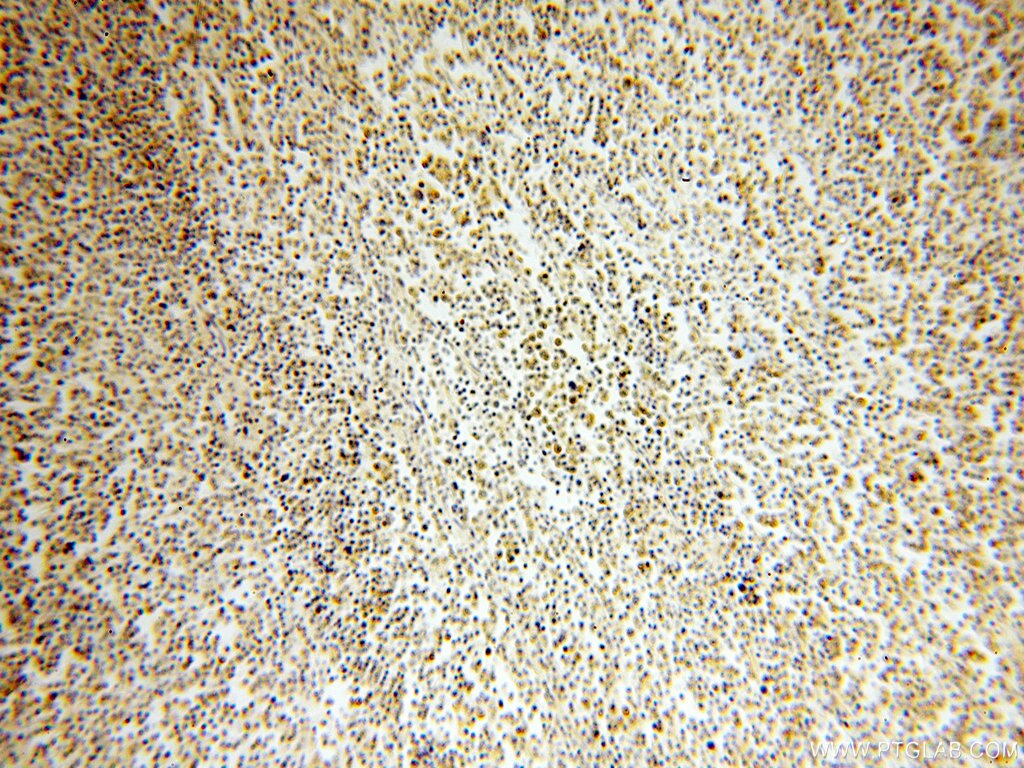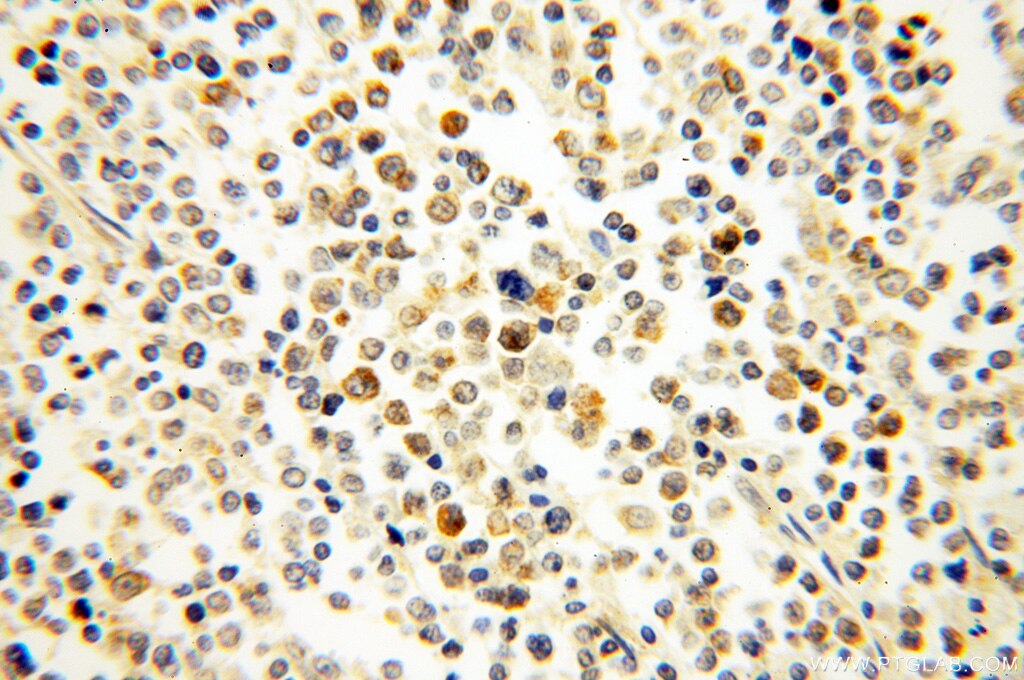- Featured Product
- KD/KO Validated
NSD3 Polyklonaler Antikörper
NSD3 Polyklonal Antikörper für WB, IHC, IF/ICC, IP, ELISA
Wirt / Isotyp
Kaninchen / IgG
Getestete Reaktivität
human, Maus, Ratte
Anwendung
WB, IHC, IF/ICC, IP, chIP, ELISA
Konjugation
Unkonjugiert
Kat-Nr. : 11345-1-AP
Synonyme
Galerie der Validierungsdaten
Geprüfte Anwendungen
| Erfolgreiche Detektion in WB | HeLa-Zellen, HEK-293-Zellen, Mausherzgewebe, Rattenherzgewebe |
| Erfolgreiche IP | HeLa-Zellen |
| Erfolgreiche Detektion in IHC | humanes Lymphomgewebe Hinweis: Antigendemaskierung mit TE-Puffer pH 9,0 empfohlen. (*) Wahlweise kann die Antigendemaskierung auch mit Citratpuffer pH 6,0 erfolgen. |
| Erfolgreiche Detektion in IF/ICC | HeLa-Zellen, MCF-7-Zellen |
Empfohlene Verdünnung
| Anwendung | Verdünnung |
|---|---|
| Western Blot (WB) | WB : 1:500-1:1000 |
| Immunpräzipitation (IP) | IP : 0.5-4.0 ug for 1.0-3.0 mg of total protein lysate |
| Immunhistochemie (IHC) | IHC : 1:20-1:200 |
| Immunfluoreszenz (IF)/ICC | IF/ICC : 1:50-1:500 |
| It is recommended that this reagent should be titrated in each testing system to obtain optimal results. | |
| Sample-dependent, check data in validation data gallery | |
Veröffentlichte Anwendungen
| KD/KO | See 3 publications below |
| WB | See 9 publications below |
| IHC | See 6 publications below |
| IF | See 2 publications below |
| ChIP | See 1 publications below |
Produktinformation
11345-1-AP bindet in WB, IHC, IF/ICC, IP, chIP, ELISA NSD3 und zeigt Reaktivität mit human, Maus, Ratten
| Getestete Reaktivität | human, Maus, Ratte |
| In Publikationen genannte Reaktivität | human |
| Wirt / Isotyp | Kaninchen / IgG |
| Klonalität | Polyklonal |
| Typ | Antikörper |
| Immunogen | NSD3 fusion protein Ag1894 |
| Vollständiger Name | Wolf-Hirschhorn syndrome candidate 1-like 1 |
| Berechnetes Molekulargewicht | 1437 aa, 162 kDa |
| Beobachtetes Molekulargewicht | 160-170 kDa, 68-72 kDa |
| GenBank-Zugangsnummer | BC012059 |
| Gene symbol | WHSC1L1 |
| Gene ID (NCBI) | 54904 |
| Konjugation | Unkonjugiert |
| Form | Liquid |
| Reinigungsmethode | Antigen-Affinitätsreinigung |
| Lagerungspuffer | PBS mit 0.02% Natriumazid und 50% Glycerin pH 7.3. |
| Lagerungsbedingungen | Bei -20°C lagern. Nach dem Versand ein Jahr lang stabil Aliquotieren ist bei -20oC Lagerung nicht notwendig. 20ul Größen enthalten 0,1% BSA. |
Hintergrundinformationen
WHSC1L1, also named as NSD3 and DC28, belongs to the histone-lysine methyltransferase family and SET2 subfamily. It is histone methyltransferase. WHSC1L1 is a potently transforming oncogenes based on the number of altered phenotypes expressed by the cells. It contains a PWWP-domain that is a methyl-lysine recognition motif involved in histone code modification and epigenetic regulation of gene expression. Knockdown of WHSC1L1 in 8p11-12-amplified breast cancer cells resulted in profound loss of growth and survival of these cells. (PMID: 20940404). This antibody recognize the long isoform (160-170 kDa) and short isoform (68-72 kDa).
Protokolle
| Produktspezifische Protokolle | |
|---|---|
| WB protocol for NSD3 antibody 11345-1-AP | Protokoll herunterladen |
| IHC protocol for NSD3 antibody 11345-1-AP | Protokoll herunterladen |
| IF protocol for NSD3 antibody 11345-1-AP | Protokoll herunterladen |
| IP protocol for NSD3 antibody 11345-1-AP | Protokoll herunterladen |
| Standard-Protokolle | |
|---|---|
| Klicken Sie hier, um unsere Standardprotokolle anzuzeigen |
Publikationen
| Species | Application | Title |
|---|---|---|
Cancer Res NSD3-Induced Methylation of H3K36 Activates NOTCH Signaling to Drive Breast Tumor Initiation and Metastatic Progression. | ||
Cancer Res Transforming properties of 8p11-12 amplified genes in human breast cancer.
| ||
Mol Oncol Amplification of WHSC1L1 regulates expression and estrogen-independent activation of ERα in SUM-44 breast cancer cells and is associated with ERα over-expression in breast cancer. | ||
Sci Rep NSD2 contributes to oncogenic RAS-driven transcription in lung cancer cells through long-range epigenetic activation. | ||
Sci Rep WHSC1L1-mediated EGFR mono-methylation enhances the cytoplasmic and nuclear oncogenic activity of EGFR in head and neck cancer.
|














